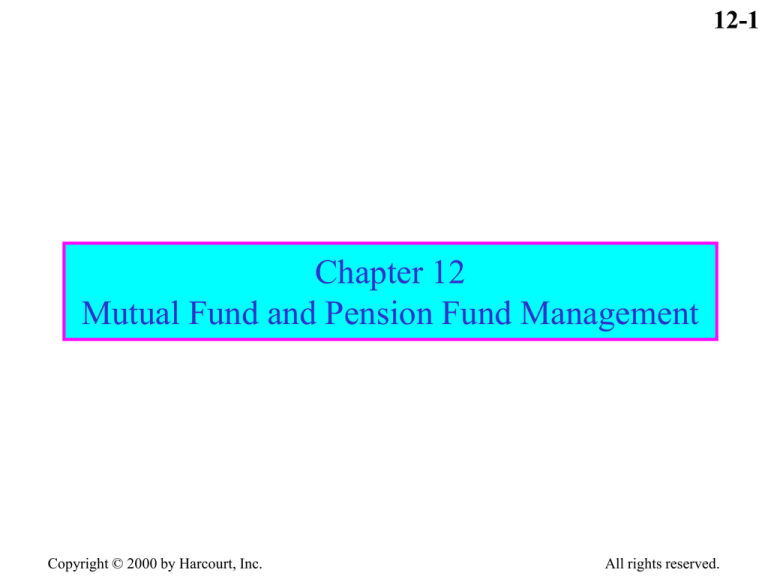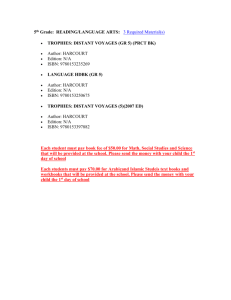
12-1
Chapter 12
Mutual Fund and Pension Fund Management
Copyright © 2000 by Harcourt, Inc.
All rights reserved.
12-2
Statistics
By the end of 1997, 37.4% of U.S.
households owned shares in mutual funds,
up from 5.7% in 1980 and 25% in 1990.
The share of financial assets controlled by
mutual funds increased from 3.68% in 1980
to 21.74% in 1997, making mutual funds
the second largest financial institution in the
U.S.
Copyright © 2000 by Harcourt, Inc.
All rights reserved.
Structure of Mutual Fund Management
12-3
Shareholders
Board of Directors
Oversees the fund’s activities, including approval of the contract with the
management company and certain other service providers.
Mutual Fund
Investment Advisory/
Management
Company
Manages the fund’s
portfolio according to
the objectives and
policies described by
the fund’s prospectus.
Independent
Public Accountant
Certify the fund’s
financial statements.
Distributor
Sells fund shares,
either directly to the
public or through
other firms.
Copyright © 2000 by Harcourt, Inc.
Custodian
Holds the fund’s
assets, maintaining
them separately to
protect shareholders
Transfer Agent
Processes order to
buy and redeem
fund shares.
All rights reserved.
12-4
Companies that manage the funds are often
owned by other companies or privately
owned.
Almost all mutual funds are externally
managed, with operations conducted by
investment companies and other affiliated
organizations and independent contractors.
By law, at least 40% of the board of
directors must be independent of the fund’s
investment advisors.
Copyright © 2000 by Harcourt, Inc.
All rights reserved.
12-5
Recent Diversification and Consolidation
Trends of Mutual Funds
Investment companies have diversified their
products to include a wide range of
financial services, including:
• discount brokerage;
• automated bill paying;
• insurance and annuities;
• debit cards; and
• internet-based investing and home-banking
services.
Copyright © 2000 by Harcourt, Inc.
All rights reserved.
12-6
Consolidation has occurred for several
reasons including:
• product line expansion;
• expansion of customer segments; and
• elimination of unprofitable mutual funds.
Investment companies have expanded into
new markets in Asia and Europe where
investors do not commonly invest in mutual
funds.
Copyright © 2000 by Harcourt, Inc.
All rights reserved.
12-7
Types of Investment Companies
Open-end investment companies
Closed-end investment companies
Unit investment trusts
Copyright © 2000 by Harcourt, Inc.
All rights reserved.
12-8
Open-end Mutual funds
Continuously sell shares to the public.
Are obligated to buy or sell their shares at a
fund’s net asset value (NAV) or share price.
NAV is equal to:
Market Value in Dollars of Fund Securities - Its Liabilities
Number of Investor Shares Outstanding
Copyright © 2000 by Harcourt, Inc.
All rights reserved.
12-9
Funds usually value exchange-traded
securities using the most recent closing
price from the exchange in which the
securities are primarily traded.
Open-end funds have liquidity needs
because cash receipts from security sales
are often delayed while redemption requests
are typically honored at the end of the day’s
NAV with checks cut the next day.
Copyright © 2000 by Harcourt, Inc.
All rights reserved.
12-10
Closed-end Mutual Funds
Funds issue a fixed number of shares and do
not redeem shares.
Once issued, shares are traded on exchanges
or over the counter, with supply and
demand determining the share price which
can be below or above NAV.
Often, closed-end fund shares trade at a
discount, i.e, below NAV.
Copyright © 2000 by Harcourt, Inc.
All rights reserved.
12-11
Unit Investment Companies
They often issue unit investment trust (UITs)
that offer interests in a fixed portfolio of
securities that are held passively for an agreed
period of time. Assets are then distributed
among shareholders.
Real estate investment trusts (REITs) similarly
offer shares in real estate investments.
Unit trusts may redeem shares at NAV, but may
only redeem shares in large blocks.
Copyright © 2000 by Harcourt, Inc.
All rights reserved.
12-12
Percentage Allocation of Mutual Fund Assets
Type
1975
1991
Equity Fund
81.7%
27.3%
Bond-Income Fund
10.2%
32.6%
Money Market Fund
8.1%
40.1%
Beg 1998
53%
23%
24%
Between 1975 and 1998, total investments in mutual
funds grew from $45 billion to $4.9 trillion.
Mutual funds, within each class, have a wide variety of
investment objectives.
At the end of 1997, mutual funds owned 19% of U.S
corporate securities, 8% of U.S Treasury and agency
securities, 10% of corporate and foreign bonds, and
32% of municipal securities.
Copyright © 2000 by Harcourt, Inc.
All rights reserved.
12-13
Cost of Mutual Fund Ownership
No-load funds
• No sale charges or Rule 12b-1 fees.
• Rule 12b-1 fees are annual charges to cover the
cost of sales commissions and other marketing
expenses and cannot exceed 1% of the fund’s
average net assets per year.
Low-load funds
• Include Rule 12b-1 fees but no sale charges.
Copyright © 2000 by Harcourt, Inc.
All rights reserved.
12-14
Load funds
• Front-load - upfront sales charge not to exceed
8.5% of the investment.
• Back-end load - charged at time of redemption.
Other costs include fees and commissions
paid to agents responsible for mutual fund
services such as management fees paid to
advisors.
• Management fees are typically .5% to 1% of
fund assets annually.
• Fees vary widely according to type of securities
held and fund turnover.
Copyright © 2000 by Harcourt, Inc.
All rights reserved.
12-15
Regulation of Mutual Funds
Investment Act of 1940
• Requires all mutual funds to register with the SEC
and to meet certain operating standards.
• Limits the ability of a mutual fund to take on
financial leverage.
– Can’t issue senior securities
– Can only borrow from banks and limits fund loans to
33.3% of funds assets.
– With the SEC’s recent interpretation of the act, mutual
funds have access to other sources of short-term
borrowing provided that stockholders and directors
approve of such sources.
Copyright © 2000 by Harcourt, Inc.
All rights reserved.
12-16
The National Securities Market Improvement
Act of 1996:
• eliminates state regulation of mutual funds;
• allows mutual funds to buy shares in other mutual
funds; and
• allows shares of unregistered private pools, such
as hedge funds and venture capital funds, to be
offered in an unlimited amount to “qualified
shareholders.”
Subchapter M of the Internal Revenue Code
• Investment companies pay no tax on investment
dividends, capital gains, or income if 90% of these
payments are distributed to shareholders.
Copyright © 2000 by Harcourt, Inc.
All rights reserved.
12-17
Regulatory Concerns
Complexity of mutual fund prospectuses
Oversight of mutual fund boards on fund
management
Exaggerated fund performance claims in
advertisements
Concerns over fund mergers
Copyright © 2000 by Harcourt, Inc.
All rights reserved.
12-18
Risk-adjusted Performance Measures
Standard Deviation of Returns (STD)
Value at Risk (VAR)
Sharp Ratio
Modigliani or M-Square Measure
Morningstar Ratings
Copyright © 2000 by Harcourt, Inc.
All rights reserved.
12-19
Standard Deviation of Returns
STD = [1/N × Sum (Ri - mean R)
Use monthly returns.
Fund managers are interested in excess returns
over the risk-free rate or some appropriate
benchmark index based on the fund’s objective.
The excess return is referred to as a fund’s
tracking error.
Copyright © 2000 by Harcourt, Inc.
All rights reserved.
12-20
Sharpe Ratio
Average Monthly Excess Return
Standard Deviation of Monthly Excess Returns
To annualize ratio, multiply the monthly ratio
by the square root of 12.
The higher the ratio, the higher the fund’s
return for any level of risk.
Ratio can serve as a basis for comparing funds
with different risk levels.
Copyright © 2000 by Harcourt, Inc.
All rights reserved.
12-21
Modigliani or M-Square Measure
Fund’s Average Excess Return × STD of Index Excess Return
STD of the Funds’ Excess Return
Provides a measure equivalent to the return the fund
would earn if its risk was the same as the market
index.
The higher the ratio, the higher the fund’s return for
any level of risk.
Copyright © 2000 by Harcourt, Inc.
All rights reserved.
12-22
Morningstar Ratings
Morningstar Return = Load-Adjusted Fund Excess Return
Ave. Excess Return for Asset Class
Load-adjusted excess return subtracts the sales loads
and the 90 day T-bill rate from the monthly fund
returns.
Copyright © 2000 by Harcourt, Inc.
All rights reserved.
12-23
Morningstar Risk = Fund’s Average Underperformance
Ave. Underperformance of Its Asset Class
Underperformance is measured by counting the number
of months that a fund’s excess return was negative,
summing all negative returns, and dividing this sum by
the total number of months over the measurement
period.
To rate funds, Morningstar subtracts the risk score from
the return score and ranks funds by this raw score
within their asset class.
Copyright © 2000 by Harcourt, Inc.
All rights reserved.
12-24
Pension Plan
Private pension plans
• Types of plans:
– defined benefits (DB); and
– defined contribution (DC).
• Meet obligations through the accumulation of
assets.
Federal pension plans
• Social Security is the largest federal plan.
• Social Security is a “pay-as-you-go” system.
Copyright © 2000 by Harcourt, Inc.
All rights reserved.
12-25
State and local government plans
• Accumulate assets to pay for retirement
benefits.
• Are not regulated by the same federal laws that
govern private pension plans.
• Management differs from state to state
depending on regulation and objectives.
Copyright © 2000 by Harcourt, Inc.
All rights reserved.
12-26
DB Plans
Promise a specified benefit or income
stream at retirement.
The employer bears all the investment risk.
• Employer makes contributions based on the age
of the plan participant, the level of benefits
promised, and the plan’s expected investment
return.
ERISA of 1974 mandates that plans be fully
funded.
Copyright © 2000 by Harcourt, Inc.
All rights reserved.
12-27
A plan is fully funded if the present value of
its assets equals the present value of the
future pension obligations minus the present
value of future contributions.
Fund liabilities are estimated using actuarial
methods.
ERISA established the Pension Benefit
Guaranty Corporation (PBGC) to assure,
within limits, the payment of up to 85% of
the vested benefits if a defined benefits
pension fund fails.
Copyright © 2000 by Harcourt, Inc.
All rights reserved.
12-28
DC Plans
Per-employee contributions are specified
but the amount of retirement income is not
specified. Retirement income depends on:
• the plan’s investment returns; and
• the age and life expectancy of the plan’s owner
at retirement.
401(k) plans are employer-sponsored DC
plans.
Copyright © 2000 by Harcourt, Inc.
All rights reserved.
12-29
ERISA allowed IRAs for individuals with no access
to private pension plans at work.
• Currently, people covered by private pension plans
may also have IRAs.
Roth IRAs allow anyone to make a contribution
regardless of whether they actively participate in a
retirement plan.
• Contributions are limited to $2,000 and are not taxdeductible.
Keogh or H.R. 10 plans allow self-employed
individuals and proprietors with small businesses to
set up individual DC plans for themselves and their
employees.
Copyright © 2000 by Harcourt, Inc.
All rights reserved.
12-30
Management Issues in DB Plans
What is the pension contract between all
plan stakeholders?
How good is pension fund performance
adjusted for risk and management costs?
What is the optimal allocation for pension
assets?
Who owns pension surplus assets?
Copyright © 2000 by Harcourt, Inc.
All rights reserved.
12-31
Should an active or passive asset allocation
management policy be pursued? Decision
depends on:
• performance return of the passive policy;
• management cost entailed in following an active
policy; and
• the additional risk entailed in following an active
strategy.
• Other active management considerations include:
– fund managers investment style;
– management fees;
– the use of managed futures; and
– the timing and frequency of asset rebalancing.
Copyright © 2000 by Harcourt, Inc.
All rights reserved.
12-32
Should pension fund smoothing be used?
• Smoothing is used to achieve a return equal to
the assumed discount rate used to project
pension benefit obligations.
• The trade-off is a reduction in a plan’s risk at
the expense of higher potential returns.
• Techniques employed include:
– guaranteed investment contracts (GIC);
– dedicated bond portfolios; and
– portfolio insurance or insured asset allocation.
Copyright © 2000 by Harcourt, Inc.
All rights reserved.
12-33
Cash Balance Plans (CBP)
They are like DB plans in that:
• the defined benefit is an agreement to a
minimum rate of interest on employees’
accounts;
• they are insured by PBGC and are subject to
ERISA regulations; and
• benefits are generally paid out in lump sums.
Copyright © 2000 by Harcourt, Inc.
All rights reserved.
12-34
CBPs are similar to DC plans in that:
• the employer contributes a minimum percentage
of pay to the employees’ retirement accounts;
• employees receive regular account statements of
benefits; and
• employees can take the accrued benefits with them
if they leave the employer.
The advantages of CBPs to an employer are:
• lower administration costs;
• lower legal exposure; and
• lower cost of educating employees.
Copyright © 2000 by Harcourt, Inc.
All rights reserved.
12-35
The disadvantage for the employer is that it
continues to bear the investment risk.
Employees carry the risk of inflation and
the risk of outliving the accrued benefits of
their plans like in the DC plan.
Copyright © 2000 by Harcourt, Inc.
All rights reserved.
12-36
Information for Risk/Return Measures for XYZ Fund
Month
XYX
Return (%)
1
2
3
4
5
6
7
8
9
10
11
12
-1.66
3.37
3.26
4.61
4.40
-1.45
-6.23
4.82
3.86
1.56
4.36
3.51
Benchmark
Risk-Free Benchmark XYZ Excess Excess
Rate (%) Return (%) Return(%) Return (%)
.46
.41
.43
.41
.43
.42
.44
.44
.43
.44
.42
.44
Arithmetic Mean
Monthly
2.03
Annualized
24.41
Standard Deviation
Monthly
3.27
Annualized
11.34
Copyright © 2000 by Harcourt, Inc.
XYZ Excess
Return Over
Benchmark (%)
.16
3.43
1.87
5.59
3.93
-3.79
-8.45
5.94
3.76
-1.45
4.36
2.41
-2.12
2.96
2.83
4.20
3.97
-1.87
-6.67
4.38
3.43
1.12
3.94
3.07
-.30
3.20
1.44
5.18
3.51
-4.21
-8.89
5.50
3.33
-1.89
3.94
1.97
-1.82
-.06
1.39
-.98
.47
2.34
2.22
-1.12
.10
3.01
.00
1.10
1.48
17.77
1.60
19.25
1.05
12.60
.55
6.64
4.06
14.06
3.28
11.36
4.06
14.08
1.43
4.97
All rights reserved.
12-37
Value at Risk (VAR) for XYZ Fund
Mean Monthly Return = 2.03
STD of Monthly Return =3.27%
At the 95% confidence interval based on a normal
distribution, the VAR is
2.03% - (1.96)(3.27) = - 4.38%
There is 2.5% probability of losing no more than
$43.80 a month for a $1,000 investment
Copyright © 2000 by Harcourt, Inc.
All rights reserved.
12-38
Sharpe Ratio for XYZ Fund
Monthly Mean Excess Return = 1.60%
Monthly Standard Deviation of Excess Return
= 3.28%
1.60%
Sharpe Ratio =
= .49 monthly
3.28%
Sharpe Ratio Annually = .49 × the square root of
12 = 1.69
Copyright © 2000 by Harcourt, Inc.
All rights reserved.
12-39
M-Squared Measure For XYZ Fund
Annualized Mean Excess Return for the Fund
= 19.25%
Annualized Standard Deviation of Excess
Return for the Fund = 11.36%
Standard Deviation of Excess Returns for the
S&P 500 index = 15%
M-squared = 19.25%
11.36%
Copyright © 2000 by Harcourt, Inc.
×
15% = 25.42%
All rights reserved.








